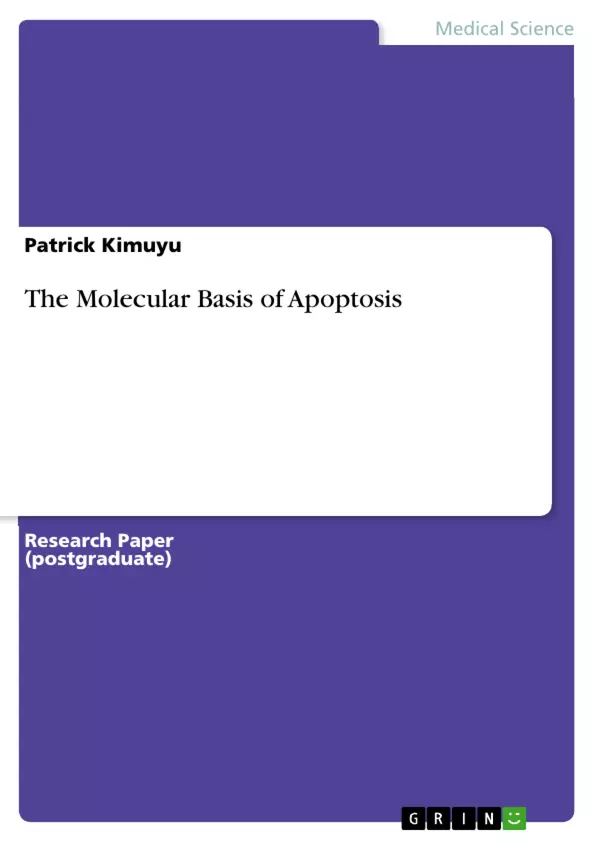Apoptosis refers to a programmed cell death; a biological process in which the body of an organism destroys its cells for different reasons. In reality, apoptosis and necrosis involve different mechanisms, and this implies they are different. In addition, the changes that occur in the process of cell death are differing in terms of morphology and chemical composition.
Evidence indicates that there are various factors that make cells commit suicide. In most cases, cells commit suicide due to imbalances between positive and negative signals that determine cell survival. Cells can consider committing suicide upon the recipient of negative signals.
This research will provide a comprehensive overview of apoptosis. It will discuss mechanisms of apoptosis and the factors involved in the process. It will also explain the association between apoptosis.
Inhaltsverzeichnis (Table of Contents)
- Abstract
- Introduction
- Distinguishing Apoptosis from Necrosis
- Factors Leading to Cell Suicide
Zielsetzung und Themenschwerpunkte (Objectives and Key Themes)
This research paper aims to provide a comprehensive overview of apoptosis, a programmed cell death process. It explores the mechanisms of apoptosis, the factors that trigger it, and differentiates it from necrosis.
- Mechanisms of Apoptosis
- Distinction between Apoptosis and Necrosis
- Factors Triggering Apoptosis (Positive and Negative Signals)
- Role of Apoptosis in Biological Processes
- Consequences of Apoptosis Imbalance
Zusammenfassung der Kapitel (Chapter Summaries)
Abstract: This abstract introduces apoptosis as a programmed cell death process, highlighting its distinction from necrosis in terms of mechanisms, morphology, and chemical composition. It emphasizes the role of imbalances between positive and negative signals in triggering apoptosis and previews the paper's comprehensive overview of the process.
Introduction: This chapter defines apoptosis as a naturally occurring process in development, aging, and homeostasis, crucial in immune responses and disease. It contrasts apoptosis with necrosis, explaining that while various stimuli can initiate both, the type of stimulus and its intensity determine the cell death pathway. The chapter underscores apoptosis as an energy-dependent and coordinated process, a 'programmed cell death,' involving a cascade of events linking initiating stimuli to cell demise. The complexity of apoptosis and the diverse stimuli triggering it are central to the chapter's argument.
Distinguishing Apoptosis from Necrosis: This section differentiates apoptosis from necrosis. Necrosis, characterized by cell injury from mechanical damage or toxins, involves swelling, membrane disruption, and subsequent inflammation. In contrast, apoptosis is an orderly process where cells shrink, display "eat me" signals, and are engulfed by phagocytes, preventing inflammation. Despite their differences, the chapter highlights the "apoptosis-necrosis continuum," indicating overlapping biochemical pathways between the two processes.
Factors Leading to Cell Suicide: This chapter focuses on the factors triggering apoptosis. It explains that imbalances between positive and negative signals determine cell survival. Withdrawal of positive signals (e.g., growth factors, IL-2) or the presence of negative signals (e.g., defective proteins, accumulated oxidants, activators like lymphotoxin, FasL, and TNF-α) can initiate apoptosis. Agents like X-rays, UV light, and chemotherapeutic drugs can generate these negative signals. The chapter emphasizes the delicate balance required for cell survival and the various factors that disrupt this equilibrium, leading to programmed cell death.
Schlüsselwörter (Keywords)
Apoptosis, programmed cell death, necrosis, cell survival, positive signals, negative signals, growth factors, Interleukin-2 (IL-2), lymphotoxin, Fas ligand (FasL), Tumor necrosis factor-alpha (TNF-α), DNA damage, cell death mechanisms, inflammation, phagocytes.
Frequently Asked Questions: A Comprehensive Overview of Apoptosis
What is the purpose of this document?
This document provides a comprehensive preview of a research paper on apoptosis, a programmed cell death process. It includes the table of contents, objectives and key themes, chapter summaries, and keywords. The preview aims to give a thorough understanding of the paper's scope and content.
What are the key themes explored in the research paper?
The paper explores the mechanisms of apoptosis, differentiates it from necrosis, examines the factors (both positive and negative signals) that trigger apoptosis, investigates its role in biological processes, and discusses the consequences of apoptosis imbalance.
What are the main differences between apoptosis and necrosis?
Apoptosis is a programmed, energy-dependent, and orderly process involving cell shrinkage, "eat me" signals, and phagocytosis without inflammation. Necrosis, on the other hand, is caused by cell injury (e.g., from toxins or mechanical damage), resulting in swelling, membrane disruption, and inflammation. While distinct, there's an "apoptosis-necrosis continuum" suggesting overlapping biochemical pathways.
What factors trigger apoptosis?
Apoptosis is triggered by an imbalance between positive and negative signals. Withdrawal of positive signals (like growth factors and IL-2) or the presence of negative signals (like defective proteins, accumulated oxidants, and activators such as lymphotoxin, FasL, and TNF-α) can initiate apoptosis. External agents such as X-rays, UV light, and chemotherapeutic drugs can also generate these negative signals.
What is the role of positive and negative signals in apoptosis?
The balance between positive and negative signals determines cell survival. Positive signals promote cell survival, while negative signals trigger apoptosis. An imbalance, where negative signals outweigh positive signals, leads to programmed cell death.
What are the key chapters covered in the research paper?
The paper includes an abstract, introduction, a chapter distinguishing apoptosis from necrosis, and a chapter detailing the factors leading to cell suicide (apoptosis).
What are the keywords associated with this research paper?
Keywords include: Apoptosis, programmed cell death, necrosis, cell survival, positive signals, negative signals, growth factors, Interleukin-2 (IL-2), lymphotoxin, Fas ligand (FasL), Tumor necrosis factor-alpha (TNF-α), DNA damage, cell death mechanisms, inflammation, phagocytes.
What is the overall objective of the research paper?
The research paper aims to provide a comprehensive overview of apoptosis, detailing its mechanisms, triggers, and differentiation from necrosis.
- Quote paper
- Patrick Kimuyu (Author), 2018, The Molecular Basis of Apoptosis, Munich, GRIN Verlag, https://www.hausarbeiten.de/document/388313


